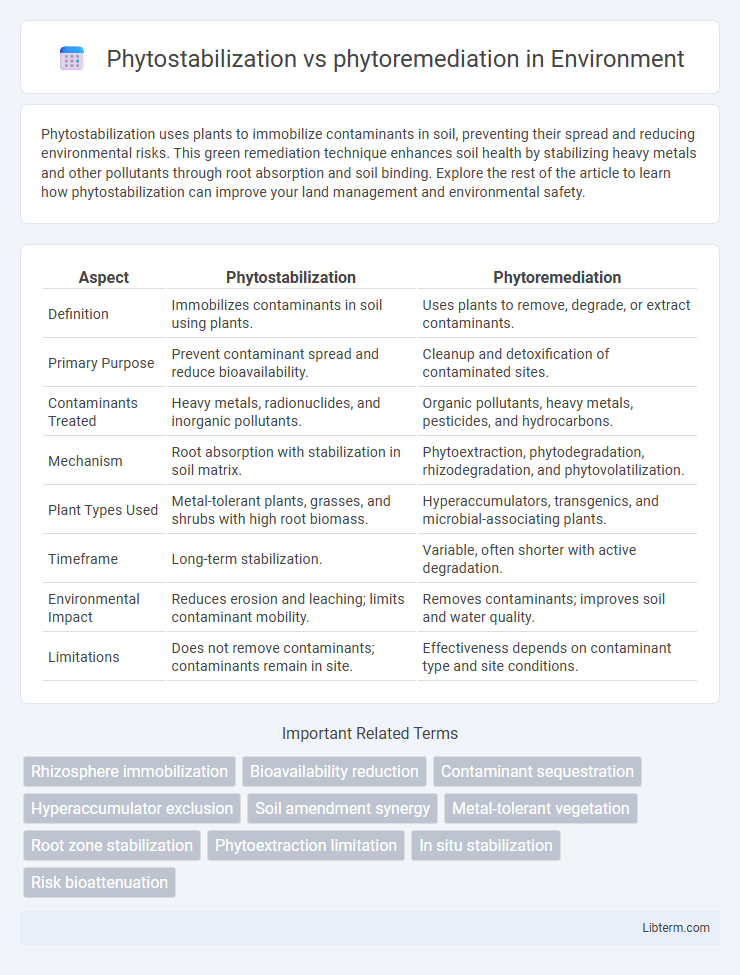Phytostabilization uses plants to immobilize contaminants in soil, preventing their spread and reducing environmental risks. This green remediation technique enhances soil health by stabilizing heavy metals and other pollutants through root absorption and soil binding. Explore the rest of the article to learn how phytostabilization can improve your land management and environmental safety.
Table of Comparison
| Aspect | Phytostabilization | Phytoremediation |
|---|---|---|
| Definition | Immobilizes contaminants in soil using plants. | Uses plants to remove, degrade, or extract contaminants. |
| Primary Purpose | Prevent contaminant spread and reduce bioavailability. | Cleanup and detoxification of contaminated sites. |
| Contaminants Treated | Heavy metals, radionuclides, and inorganic pollutants. | Organic pollutants, heavy metals, pesticides, and hydrocarbons. |
| Mechanism | Root absorption with stabilization in soil matrix. | Phytoextraction, phytodegradation, rhizodegradation, and phytovolatilization. |
| Plant Types Used | Metal-tolerant plants, grasses, and shrubs with high root biomass. | Hyperaccumulators, transgenics, and microbial-associating plants. |
| Timeframe | Long-term stabilization. | Variable, often shorter with active degradation. |
| Environmental Impact | Reduces erosion and leaching; limits contaminant mobility. | Removes contaminants; improves soil and water quality. |
| Limitations | Does not remove contaminants; contaminants remain in site. | Effectiveness depends on contaminant type and site conditions. |
Introduction to Phytostabilization and Phytoremediation
Phytostabilization involves using plants to immobilize contaminants in soil and prevent their migration, effectively reducing the bioavailability of heavy metals and toxic substances. Phytoremediation encompasses a broader range of plant-based techniques, including phytoextraction, phytodegradation, and phytostabilization, aimed at cleaning up pollutants from soil, water, and air. Both strategies offer eco-friendly and cost-effective approaches to environmental remediation, with phytostabilization primarily focusing on containment, while phytoremediation emphasizes contaminant removal or transformation.
Defining Key Terms: Phytostabilization vs. Phytoremediation
Phytostabilization involves the use of plants to immobilize contaminants in soil, preventing their migration or bioavailability, primarily targeting heavy metals and other hazardous substances. Phytoremediation is a broader technique encompassing various plant-based methods to remove, degrade, or stabilize contaminants from soil, water, or air, including phytoextraction, phytodegradation, and phytovolatilization. Both strategies employ hyperaccumulator species but differ in their remediation goals--phytostabilization emphasizes containment, while phytoremediation focuses on contamination reduction or removal.
Mechanisms of Phytostabilization
Phytostabilization primarily involves the use of plants to immobilize contaminants in soil, preventing their migration through processes such as root adsorption, precipitation, and complexation. This mechanism reduces the bioavailability and mobility of heavy metals and organic pollutants by stabilizing them within the rhizosphere. Unlike broader phytoremediation techniques that aim to degrade or extract contaminants, phytostabilization focuses on containment and in situ stabilization to minimize environmental risks.
Mechanisms of Phytoremediation
Phytoremediation encompasses several mechanisms, including phytoextraction, phytostabilization, phytodegradation, phytovolatilization, and rhizofiltration, each targeting specific contaminants in soil, water, or air. Phytostabilization specifically immobilizes pollutants in the root zone, reducing their bioavailability and preventing migration, whereas phytoextraction involves uptake and accumulation of contaminants into plant tissues for subsequent removal. Understanding these mechanisms is crucial for selecting appropriate plant species and designing effective remediation strategies for heavy metals, organic pollutants, and radionuclides.
Comparative Advantages and Limitations
Phytostabilization effectively immobilizes contaminants in soil, reducing their bioavailability and preventing further environmental spread, making it ideal for areas with heavy metal pollution. Phytoremediation encompasses a broader range of processes, including phytoextraction and phytodegradation, which can remove or detoxify contaminants but often require more time and optimal environmental conditions. Limitations of phytostabilization include the potential for long-term contamination persistence, while phytoremediation may face challenges such as limited contaminant uptake capacity and sensitivity to toxic pollutants.
Suitable Plant Species for Each Method
Phytostabilization typically employs plants like poplars, willows, and certain grasses that immobilize contaminants in the soil, preventing their migration. Phytoremediation often uses hyperaccumulator species such as Indian mustard (Brassica juncea), sunflower (Helianthus annuus), and certain fern species like Pteris vittata to extract and degrade pollutants. Selection depends on contaminant type, site conditions, and plant tolerance to heavy metals or organic compounds to maximize remediation efficiency.
Ideal Site Conditions for Each Approach
Phytostabilization is ideal for sites with heavy metal contamination where immobilizing pollutants in the soil prevents their spread, typically requiring stable, well-drained soils with low erosion risk. Phytoremediation suits sites where contaminants such as organic compounds or moderate metal levels are accessible for plant uptake or degradation, benefiting from soils with good permeability and adequate nutrient availability. Both approaches thrive best in areas with suitable climate conditions supporting healthy plant growth and minimal environmental stress.
Environmental Impacts and Benefits
Phytostabilization stabilizes contaminants in soil, preventing their spread and reducing environmental risks such as erosion and groundwater contamination. Phytoremediation involves extracting or degrading pollutants through plant uptake and metabolism, actively restoring soil and water quality. Both methods enhance ecosystem health, improve soil structure, and promote biodiversity by utilizing natural plant processes for sustainable environmental management.
Case Studies and Real-World Applications
Phytostabilization involves using plants to immobilize contaminants in soil, preventing their migration, and has been effectively demonstrated in mining sites contaminated with heavy metals where species like Vetiver grass reduced leachate toxicity. Phytoremediation broadly encompasses techniques such as phytoextraction and phytodegradation, with case studies including the removal of hydrocarbons by poplar trees in oil spill sites and the degradation of pesticides by willow species in agricultural runoff areas. Real-world applications highlight phytostabilization's role in long-term containment while phytoremediation offers active contaminant removal, emphasizing site-specific strategy selection based on contaminant type and environmental conditions.
Future Prospects and Research Directions
Phytostabilization offers promising future prospects in immobilizing heavy metals in contaminated soils, reducing environmental risks while enabling the restoration of land for agricultural or ecological use. Research directions emphasize genetic engineering of hyperaccumulator plants to enhance metal tolerance and sequestration, alongside exploring microbial symbiosis to improve phytostabilization efficiency. Advances in omics technologies and field-scale trials are critical for optimizing phytoremediation strategies, addressing scalability challenges, and integrating sustainable land management practices.
Phytostabilization Infographic

 libterm.com
libterm.com